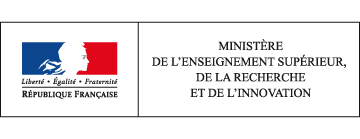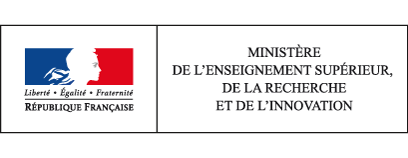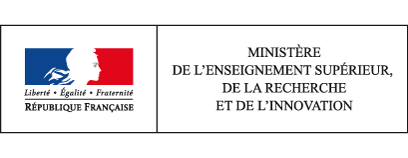MENESR-DGESIP/DGRI-SIES
Ministère de l'Éducation nationale, de l'Enseignement supérieur et de la Recherche
Direction générale de l'enseignement supérieur et de l'insertion professionnelle
Direction générale de la recherche et de l'innovation
Service de la coordination des stratégies de l'enseignement supérieur et de la recherche
Sous-direction des systèmes d'information et des études statistiques - SIES
1 rue Descartes, 75231 Paris Cédex 05
http://www.enseignementsup-recherche.gouv.fr/
This source is used in these chapters:
At the start of the 2013-2014 academic year, the number of students receiving support stood at more than 660,000, or approximately 35% of students enrolled for a course for which a grant was available. In all, the amount of financial and social support provided came to almost €6 billion in 2013, compared with €3.5 bn in 1995. [read more]
In 2013, there were 2,430,100 students, 8 times as many as in 1960. Today, a little over six students in every ten are enrolled at university. However, in the last 10 years, most of this dynamism has been concentrated in private higher education. In 2013 this sector accounted for almost 18% of all students. [read more]
About 75% of baccalauréat holders from 2013 enrolled immediately in a higher education course (excluding work study programmes). More than half of those with a general baccalauréat enrolled at university but their numbers were down almost 7 percentage points compared with 2000. Almost one in two holders of a technological baccalauréat enrolled in a short vocational course. More and more of those with a vocational baccalauréat, whose numbers have increased substantially with the reform of the professional path, enrolled in higher education. [read more]
At the start of the 2013-2014 academic year, students holding a general baccalauréat represented 79.2% of new baccalauréat holders enrolled at university. The proportion entering IUTs had grown by 3.5 points since 2004 and reached 67.5% in 2013, but was in decline compared with 2012. STSs still recruit mainly technological baccalauréat holders, but the proportion is decreasing as numbers of vocational baccalauréat holders increase. [read more]
There was a marked increase (+1.8%) in the total number of students in higher education, with 2,430,100 enrolled at the start of the 2013-14 academic year – the highest number to date. This increase is explained by the fact that higher education today has much greater appeal, even though there are fewer young people of studying age. Young women make up the majority of students and graduates. [read more]
In higher education in France, 295,100 students are foreign nationals, or one student in eight. Over the last ten years, foreign students account for almost a third (29%) of growth in student numbers. Three quarters of foreign students study at university. Proportionally there are more foreign students in the Master's (18%) and PhD (41%) programmes than in the Bachelor's degree (11%). [read more]
In the 5th year after obtaining their baccalauréat, 72% of students who enrolled in higher technical sections and 89% of those who enrolled in university institutes of technology had obtained a higher education diploma, 22% and 52% (respectively) with a Bac + 3-level qualification. After two or three years, eight out of ten students with a baccalauréat who had enrolled in classes preparing for admission to Grandes Écoles in scientific or business subjects were enrolled on a Bac + 5-level programme in a school. Conversely, nearly half of the students who had initially enrolled in classes preparing for admission to Grandes Écoles in arts and humanities subjects went to university, even though the number going to a Grande École had increased. [read more]
Slightly fewer students who started the first year of a Bachelor's degree in 2009 obtained their degree in three years, compared with those who went into the first year in 2005 (-1.7%). However, the proportion of those obtaining a Bachelor's degree in 3 or 4 years remained stable at nearly 40%. 47% of students on Master's degree programmes obtained their degree in two years and 57% in three years, an increase of eight points in four years. [read more]
At the start of the 2013-2014 academic year, there were 18,200 students in public universities, STSs and CPGEs who declared a disability and were provided with support of some kind. The vast majority (90%) were enrolled at university. Their numbers had doubled in 5 years. They receive more and more different types of support which are now better known and which enable students not to be set apart from the general trend of longer studies. Nevertheless, they are enrolled for the most part in the Bachelor's degree programmes and their presence declines throughout the course. [read more]
Women outnumber men in higher education (55%), but are less likely to enrol in selective or scientific courses and are in the minority in PhD programmes. In 2013, their unemployment rate three years after leaving was the same as for men, but their employment conditions were less favourable. [read more]
France’s gross domestic expenditure on research and development has doubled since 1982 and accounted for 2.23% of GDP (€46.5 billion) in 2012. Businesses alone implemented 65% of R&D expenditure and funded 59% of gross national expenditure on R&D. [read more]
In 2012, half of intramural business enterprise expenditure on R&D (BERD) was focused on six of the 32 industrial branches that benefit from R&D (‘Manufacture of motor vehicles’, ‘Manufacture of air and spacecraft and related machinery’, ‘Manufacture of basic pharmaceutical products and pharmaceutical preparations’, ‘Computer-related and information service activities’, ‘Professional, scientific and technical activities’ and ‘Manufacture of chemicals and chemical products’). In the public sector, dedicated research institutions (EPST and EPIC) carried out 55% of all R&D funded by intramural government expenditure on R&D (GOVERD). [read more]
In 2012, SMEs accounted for 86% of enterprises carrying out R&D work in France. They represented 16% of intramural business enterprise R&D expenditure (BERD), half of which was invested in the service sector. Large enterprises, which accounted for 59% of BERD, focused three quarters of their R&D efforts in the high and medium-high technology industries. [read more]
In 2012, the gross domestic expenditure on R&D (GERD) of France's main public research institutions amounted to €9.1 billion, a fall of 1.1% in relation to 2011. These institutions carry out 55% of public research and are key stakeholders in research and development in France. The French National Centre for Scientific Research (CNRS) and the civil division of the French Alternative Energies and Atomic Energy Commission (CEA) conduct a third of public research, with GERD of €5.5 billion. [read more]
In 2012, budget allocations spent on public research totalled nearly €13 billion and funded 69% of all public research and development (R&D). In 2012, resources contributed by institutions themselves accounted for nearly €6 billion and almost 30% of R&D funding for public research. [read more]
The number of firms claiming the R&D tax credit (CIR) has risen sharply since the scheme was reformed in 2008. Nearly all firms currently conducting R&D in France are aware of and make use of the R&D tax credit when carrying out R&D projects. The amount of R&D tax credit paid out in 2012 totalled €5.3 billion, equivalent to 0.26% of French GDP and double the amount of direct government funding for business R&D. [read more]
In 2013, local authorities devoted €1.3 billion to funding research and technology (R&T). This funding went in large part towards property and technology transfer transactions. Regional councils accounted for 68% of this funding, while public establishments for cooperation between local authorities increased their contribution. [read more]
In 2014, the Inter-ministerial Mission for Research and Higher Education assigned budget allocations worth €14 billion to research and development. Around 80% of these allocations went to research and higher education institutions in the form of public service subsidies. Operating expenditure accounted for 13% (€1.7 billion) of the allocations, while 7% were spent on international programmes and institutions. [read more]
Businesses provide the majority (60%) of funding for gross national expenditure on R&D, with businesses based in France financing around 55% of the country’s gross domestic expenditure on R&D. This level of funding by the private sector is much lower than that recorded in Japan, Germany and the United States. [read more]
In 2012, 564,500 people were involved in research activity in France. In the last three years, the number of researchers has increased more rapidly in business enterprises (+16%) than in government (+2%). Women represent 29% of all research personnel and 26% of researchers. [read more]
One researcher in three in the government sector and one in five in business enterprises is a woman. As in other countries, women are less well represented in all sectors among researchers than in the professions providing research support. The male to female ratio in research personnel depends on the research field. [read more]
In 2011, almost 197,000 researchers were involved in R&D activity in business enterprises. This is a young population, with half aged under 38. The proportion of women is still low (20%). The majority of researchers in business enterprises hold an engineering diploma. Only 12% have a PhD. Women are strongly represented in medical and biological sciences. [read more]
At the start of the 2013-14 academic year, there were about 67,000 students enrolled in a PhD programme, of which 62,700 were in universities. In 2012, almost 13,000 PhDs were awarded. The number of doctoral students enrolled has been falling since 2007, whereas the number of PhDs awarded is increasing. This difference is mainly due to a shortening of the time taken to complete the thesis. Over half of students enrolled for the first time for a university PhD in France were not enrolled in France the previous year in a university course leading to a qualification. [read more]
‘Young innovative company’ (YIC) status was introduced to encourage people to set up and expand SMEs that carry out R&D. In 2012, their R&D expenditure totalled €730 million and was focused primarily within the service sector. [read more]
Intramural business enterprise expenditure on R&D (BERD) in the field of biotechnology totalled €2.7 billion, accounting for around 9% of BERD. This proportion has remained stable since 2006. The proportion of firms active in this field of research increased by one percentage point in one year to 11% in 2012. Firms that specialise in biotechnology are mostly small enterprises. [read more]
In 2012, nearly a quarter of firms in France (23%) that carried out R&D in-house incurred R&D expenditure in the fields of new materials or nanotechnology, an increase on the previous year. In the field of new materials, the chemicals industry remained the leading branch in terms of expenditure incurred. R&D in nanotechnology mostly involved small enterprises and was primarily focused on the ‘Manufacture of electronic components and boards’ branch. [read more]
In 2012, R&D expenditure devoted either directly or indirectly to environmental issues was estimated to be €5 billion, equivalent to 11% of France’s gross domestic expenditure on R&D. Nearly 60% of expenditure on environmental research and development (excluding Energy and Transport) was incurred by businesses (compared with 20% in 2000). [read more]



